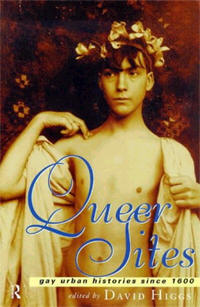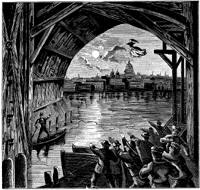 |


|
|
Gay Urban Histories Since 1600 Queer Sites: Gay Urban Histories Since 1600, Edited by David Higgs, Routledge, 1999, 214 pages, paperback, $22.99
Editor David Higgs observes that the comparison of these cities can yield information about differences and similarities in sexual cultures. The authors use legal records, diaries, and journalistic materials as their sources. This allows them to discuss quite a wide range of men. (Reportedly, the information they could find on women was limited.) The essays build upon historian John D. Emilio's argument that urbanization and industrial development created the anonymity, congregation, and freedom from family that offered men and women greater social and economic freedom and allowed homosexual subcultures to develop.
The sodomites known in London as Mollys because they met in molly taverns and pederasts in Paris taverns in the mid-1700s represented a third category. These groups served as the beginning of the development of the system of opposites. These men adopted dress and styles associated with women and assumed the passive position in intercourse, earning them the label "gender invert." This system dominated the nineteenth century understanding of same-sex behavior among the medical community and helped effeminate gay males develop subcultures in urban areas. Sibalis and Gert Hekma (Amsterdam) note that in the early twentieth century these homosexual males created masked and drag balls in Paris and NWAK, the first homosexual rights group in the Netherlands. NWAK established a meeting place and library and represents a genealogy of activist groups that continued with the Mattachine Society and Daughters of Bilitis organizations that Les Wright describes as emerging in San Francisco during the 1950s. These groups, along with the medical community, would be among the figures shaping the acceptance of the third sexual system, homosexuality, as a sexual object choice. Another important similarity among sexual cultures emerges upon considering how men with same-sex interest in these various cities used urban locations to meet their needs. Each author details those locations where the men had sex and the establishments where they congregated.
The expansion of commercial amusements and the consequent development of commercial areas in cities enabled homosexuals to have more establishments that catered to them. The essays of Hekma and Wright corroborate the arguments of Chauncey and others that establishments with homosexual clienteles existed in red light and tourist districts. Sibalis's essay among others confirms earlier works that noted that middle-class homosexuals mixed with literary and visual art bohemians in cafes within theater and tourist areas of major cities. The discussion of sexual spaces compliments the work done by previous scholars, including the authors in Public Sex / Gay Space, edited by William Leap. The consideration of establishments builds on work by historians in Brett Beemyn's Creating Space for Ourselves. Queer Sites offers a valuable introduction to the transformation of sexuality and the urban enclaves of males with same-sex interest. However, the very limited discussion of women could disappoint readers, particularly since recent books indicate a larger public role for women in urban centers at least nineteenth century. The book opens up avenues for more research into the urban life of same-sex populations. Valuable information could emerge from examining the relationship between gentrification and gays and lesbians, such as the revival of Dupont Circle in Washington, DC since the mid-1970s. Scholars could better examine the relationship between homosexuals and ethnic neighbors in cities. Brett Abrams Brett Abrams recently received his Ph.D. in U.S. history from American University. He is working on producing articles and a book from his dissertation entitled, Hooray for Hollywood: Gender and Sexual Non-Conformity In the Classical Hollywood Era. |
 © 1997-2000 BEI
© 1997-2000 BEI
 Queer Sites traces the development of dissident sexualities in seven cities worldwide. The locations investigated include four European capitals: London, Lisbon, Moscow, and Paris, plus Amsterdam and San Francisco. The six authors provide readers with insight into the specific locations that males with same-sex interest used to fulfill their desires between 1600 and today.
Queer Sites traces the development of dissident sexualities in seven cities worldwide. The locations investigated include four European capitals: London, Lisbon, Moscow, and Paris, plus Amsterdam and San Francisco. The six authors provide readers with insight into the specific locations that males with same-sex interest used to fulfill their desires between 1600 and today.
 An etching of London from the 1800s
An etching of London from the 1800s